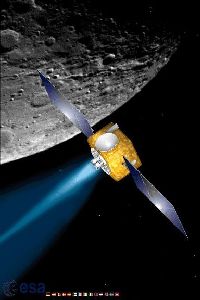Summary
Europe's first lunar adventure
The European Space Agency's Science Programme encompasses, in addition to the ambitious 'Cornerstone' and medium-sized missions, recently dubbed 'flexi-missions', small relatively low-cost missions. These have been given the generic name SMART - 'Small Missions for Advanced Research in Technology'. Their purpose is to test new technologies that will eventually be used on bigger projects.
 |
|
SMART-1 |
It is the first time that Europe has sent a spacecraft to the Moon. In addition to the use of solar electric primary propulsion to reach Earth's natural satellite, the spacecraft carries out a complete programme of scientific observations in lunar orbit.
SMART-1 was launched succesfully as an Ariane-5 auxiliary payload on 27 September 2003 and entered lunar orbit on 15 November 2004. The planetary objective selected for the SMART-1 mission was to orbit the Moon for a nominal period of 6 months, with a possible extension of one year.
On 10 February 2005 the ESA Science Programme Committee endorsed unanimously the proposed one-year extension of SMART-1, pushing back the mission end date from August 2005 to August 2006.
Implementation of the mission extension was done in two periods of 6 months that corresponded to different orbital parameters and illumination conditions. During the first period, the southern survey study was completed and dedicated pointings were made for multi-angle, stereo, and polar illumination studies.
In the second period, high-resolution coverage of the Moon on the equator and part of the northern hemisphere took place due to the favourable illumination conditions. High resolution follow up observations of specific targets were also made, as well as observations relevant for the preparation of future international lunar exploration missions (Lunar-A, Selene, Chandrayaan-1, Chang'E, LRO, Moonrise).
In the period 19 June to 2 July 2006, orbit manoeuvres were carried out to extend the mission lifetime by 2 weeks with the mission end now scheduled for 3 September 2006. This was based on the science requirements to allow the impact of the spacecraft on the Moon to be observable from Earth under favourable conditions.
SMART-1 Propulsion
The solar electric primary propulsion on-board SMART-1 is a Stationary Plasma Hall-effect thruster, the PPS-1350 developed by SNECMA, France. Using xenon gas as propellant and the power from the spacecraft's solar arrays, the thruster is capable of providing a thrust of some 70 milliNewtons. Using the thrust of the electric propulsion system, SMART-1 progressively expanded its orbit, spiralling out from Earth and was caught by the Moon's gravitational field on 15 November 2004, nearly 14 months after launch.
 |
|
To the Moon by Ion Drive |
In order to enhance the capture opportunities and to save precious fuel, SMART-1 also made use of celestial mechanics, including Moon resonances and swing-bys. The spacecraft exploited the unstable regions of space where the gravity field of Earth and Moon compete and which are normally avoided by conventional trajectories. It passed through the L1 point of the Earth-Moon system which allowed for the spacecraft to be caught by the Moon's gravity.
Two instruments (SPEDE & EPDP) are directly associated with the thruster. They monitor its performance and the propulsion's effects on the spacecraft and its payload, and are also used in scientific experiments such as sensing the lunar plasma environment.
The three-axis stabilised spacecraft, with a launch mass of approximately 350 kilograms, itself uses the most modern technologies, avionics and software. For example, the solar panels use gallium-arsenide-indium-phosphide multiple junction cells, it has an advanced attitude and orbit control system and the selected data bus architecture is the 'CAN-bus', a robust system suitable to harsh environment developed initially for the automotive industry.
Science & Technology
SMART-1's science payload, with a total mass of some 15 kilograms, features many innovative instruments and advanced technologies. These are:
- AMIE, a miniaturised high-resolution camera for lunar surface imaging
- SIR, a near-infrared point-spectrometer for lunar mineralogy investigation
- D-CIXS, a very compact X-ray spectrometer with a new type of detector and micro-collimator which will provide fluorescence spectroscopy and imagery of the Moon's surface elemental composition
- XSM, an X-ray monitor to support D-CIXS by providing measurements of solar X-ray emission for calibration
- KaTE, an experiment aimed at demonstrating deep-space telemetry and telecommand communications in the X and Ka-bands
- RSIS, a radio-science experiment relying on KaTE. It monitors the electric propulsion by means of tracking techniques. In lunar orbit it will, with AMIE, also study the Moon's libration. This experiment is also a test of what will be a crucial investigation of BepiColombo, aimed at the investigation of the planet's internal structure
During the cruise phase to reach the Moon, several of these instruments were planned to make observations of other celestial targets as opportunities would arise. For example, D-CIXS was to study X-ray sources or comets, and XSM was to look at solar flares. In addition to supporting RSIS, the AMIE micro-imager helped to validate a deep space optical link (Laser-Link Experiment), using the ESA Optical Ground station in Tenerife, and helped to validate a system of autonomous navigation (OBAN) based on image processing.
